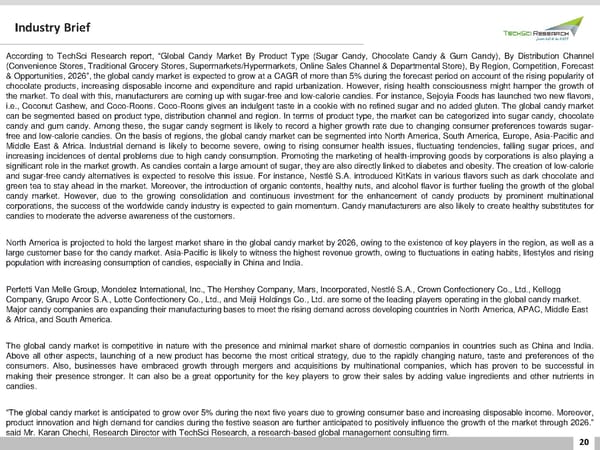Industry Brief According to TechSci Research report, “Global Candy Market By Product Type (Sugar Candy, Chocolate Candy & Gum Candy), By Distribution Channel (Convenience Stores, Traditional Grocery Stores, Supermarkets/Hypermarkets, Online Sales Channel & Departmental Store), By Region, Competition, Forecast &Opportunities, 2026”, the global candy market is expected to grow at a CAGR of more than 5% during the forecast period on account of the rising popularity of chocolate products, increasing disposable income and expenditure and rapid urbanization. However, rising health consciousness might hamper the growth of the market. To deal with this, manufacturers are coming up with sugar-free and low-calorie candies. For instance, Sejoyia Foods has launched two new flavors, i.e., Coconut Cashew, and Coco-Roons. Coco-Roons gives an indulgent taste in a cookie with no refined sugar and no added gluten. The global candy market can be segmented based on product type, distribution channel and region. In terms of product type, the market can be categorized into sugar candy, chocolate candy and gum candy. Among these, the sugar candy segment is likely to record a higher growth rate due to changing consumer preferences towards sugar- free and low-calorie candies. On the basis of regions, the global candy market can be segmented into North America, South America, Europe, Asia-Pacific and Middle East & Africa. Industrial demand is likely to become severe, owing to rising consumer health issues, fluctuating tendencies, falling sugar prices, and increasing incidences of dental problems due to high candy consumption. Promoting the marketing of health-improving goods by corporations is also playing a significant role in the market growth. As candies contain a large amount of sugar, they are also directly linked to diabetes and obesity. The creation of low-calorie and sugar-free candy alternatives is expected to resolve this issue. For instance, Nestlé S.A. introduced KitKats in various flavors such as dark chocolate and green tea to stay ahead in the market. Moreover, the introduction of organic contents, healthy nuts, and alcohol flavor is further fueling the growth of the global candy market. However, due to the growing consolidation and continuous investment for the enhancement of candy products by prominent multinational corporations, the success of the worldwide candy industry is expected to gain momentum. Candy manufacturers are also likely to create healthy substitutes for candies to moderate the adverse awareness of the customers. North America is projected to hold the largest market share in the global candy market by 2026, owing to the existence of key players in the region, as well as a large customer base for the candy market. Asia-Pacific is likely to witness the highest revenue growth, owing to fluctuations in eating habits, lifestyles and rising population with increasing consumption of candies, especially in China and India. Perfetti Van Melle Group, Mondelez International, Inc., The Hershey Company, Mars, Incorporated, Nestlé S.A., Crown Confectionery Co., Ltd., Kellogg Company, Grupo Arcor S.A., Lotte Confectionery Co., Ltd., and Meiji Holdings Co., Ltd. are some of the leading players operating in the global candy market. Major candy companies are expanding their manufacturing bases to meet the rising demand across developing countries in North America, APAC, Middle East & Africa, and South America. The global candy market is competitive in nature with the presence and minimal market share of domestic companies in countries such as China and India. Above all other aspects, launching of a new product has become the most critical strategy, due to the rapidly changing nature, taste and preferences of the consumers. Also, businesses have embraced growth through mergers and acquisitions by multinational companies, which has proven to be successful in making their presence stronger. It can also be a great opportunity for the key players to grow their sales by adding value ingredients and other nutrients in candies. “The global candy market is anticipated to grow over 5% during the next five years due to growing consumer base and increasing disposable income. Moreover, product innovation and high demand for candies during the festive season are further anticipated to positively influence the growth of the market through 2026.” said Mr. Karan Chechi, Research Director with TechSci Research, a research-based global management consulting firm. 20
 Global Candy Market Forecast 2026 Page 19 Page 21
Global Candy Market Forecast 2026 Page 19 Page 21